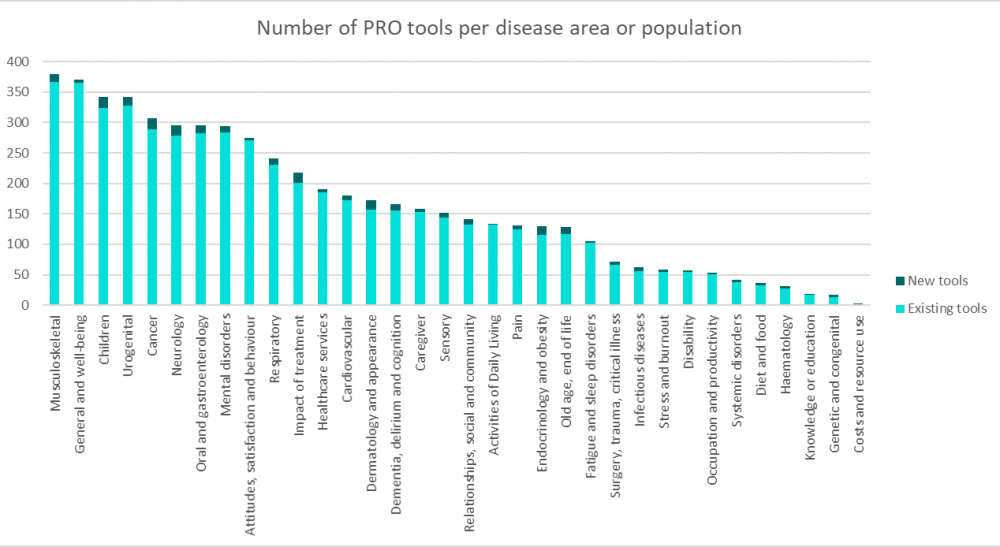An effortless and comprehensive approach to burden of illness reviews
Blog - Our PRO instrument ontology grew by 275 in 2018
Published: 07-01-2019
The heoro.com database searches PubMed every night for new studies relevant to health economics and outcomes research. The new abstracts are indexed by our artifical intelligence software to identify the relevant diseases, interventions, study types, geographical location and PRO instruments for each study. This is done by matching the content of the new abstracts to our unique ontologies of terms.
Every working day, we go through the new additions to tidy up the automated indexing and blog and tweet about some of the more relevant and interesting studies. Part of this work entails identifying new interventions and PRO instruments and adding these to the relevant ontologies. Although we find some new interventions each month, the main task is to update the PRO instrument ontology, so that future publications that have used the same tools can be indexed automatically.
In 2018 we processed over 1,500 new abstracts that were assessing quality of life, utilities and other patient-, caregiver- or clinician-reported outcomes. These 1,500-plus abstracts cited a total of 275 new PRO instruments that had not previously been included in our ontology. This means that one new PRO tool is reported in every 5 to 6 PRO study publications picked up by our search.
Here is a quick overview of the diseases and populations that had new PRO tools developed in 2018. The main areas of development have been in tools for use with children, in cancer or nervous system disorders, and tools assessing the impacts of treatment on patients. In contrast, there were relatively few instruments developed for haematological disorders, genetic disorders, infections and cardiovascular diseases.
Disease or population |
Number of new tools added in 2018 |
| Children | 18 |
| Cancer | 18 |
| Neurology | 17 |
| Impact of treatment | 16 |
| Dermatology and appearance | 15 |
| Endocrinology and obesity | 14 |
| Urogenital | 14 |
| Oral and gastroenterology | 13 |
| Musculoskeletal | 12 |
| Old age, end of life | 11 |
| Respiratory | 11 |
| Mental disorders | 10 |
| Dementia, delirium and cognition | 10 |
| Relationships, social and community | 9 |
| Sensory | 8 |
| Cardiovascular | 8 |
| Pain | 7 |
| Infectious diseases | 7 |
| Surgery, trauma, critical illness | 6 |
| Healthcare services | 6 |
| General and well-being | 5 |
| Caregiver | 5 |
| Attitudes, satisfaction and behaviour | 4 |
| Diet and food | 4 |
| Genetic and congenital | 4 |
| Systemic disorders | 4 |
| Stress and burnout | 4 |
| Haematology | 3 |
| Costs and resource use | 3 |
| Activities of Daily Living | 2 |
| Disability | 2 |
| Occupation and productivity | 2 |
| Fatigue | 1 |
| Knowledge or education | 1 |
| Sleep disorders | 1 |
| Total | 275 |
However, if we compare the number of new tools added in 2018 to the existing number of tools for that disease or population at the end of 2017, we get a different pattern of growth. Now, the topics with the greatest percentage increase in available PRO tools are genetic and congenital disorders (30.8% increase), infeectious diseases (12.5% increase), endocrinology and obesity (12.2% increase), diet and food (12.1% increase) and haematology (10.7% increase). Disease areas with the lowest percentage increase in developement of new tools are musculoskeletal disorders (3.3% increase) and mental disorders (3.5% increase), and topics and populations where relatively few new tools were developed include general well-being tools (1.4% increase), tools assessing attidudes, satisfaction and behaviour (1.5% increase) and caregiver-specific tools (3.3% increase).
This is shown in the chart below, where the light teal bars represent the number of existing instruments for that category at the end of 2017 and the dark teal bars show the new tools added in abstracts added to our database in 2018.

It is impossible for anyone to keep track of all these new instruments. We aim to make the task easier for everyone by summarising the new additions in a series of blogs where we will list the new instruments that have been developed by disease area or population. And anyone can access the heoro.com database for free and can then search to find papers that have used specific PRO instruments, or locate all PRO validation studies in a particular disease area.

Alison Martin
Head of Reviews